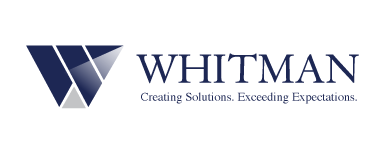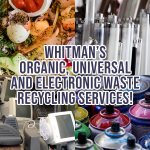The Whitman Green Team’s Monthly “Down-to-Earth” Blog Post:
Earth Day originated back on April 22, 1970, by Gaylord Nelson, a Junior Senator from Wisconsin, and Denis Hayes, a young activist. 20 million Americans, which at the time accounted for 10% of the total population of the United States, participated in the very first Earth Day which ultimately led to the creation of the United States Environmental Protection Agency (EPA) by the end of 1970. Within the next decade, several important environmental legislations were passed such as the Clean Air Act, the Water Quality Improvement Act, the Endangered Species Act, the Toxic Substances Control Act and more.
 For 2024, the global theme for Earth Day is Planet vs. Plastics. Earthday.org is demanding a 60% reduction in the production of plastic by 2040 through: 1) health awareness of the impacts of plastic to humans, animals, and all biodiversity; 2) demanding change such as rapidly phasing out single-use plastics and call for an end to fast fashion; and 3) investing in innovative technologies and materials to help us build a plastic-free world.
For 2024, the global theme for Earth Day is Planet vs. Plastics. Earthday.org is demanding a 60% reduction in the production of plastic by 2040 through: 1) health awareness of the impacts of plastic to humans, animals, and all biodiversity; 2) demanding change such as rapidly phasing out single-use plastics and call for an end to fast fashion; and 3) investing in innovative technologies and materials to help us build a plastic-free world.
Key Facts
- Plastic production has grown to more than 380 million tons per year
- More plastic has been produced in the last 10 years than in the entire 20th century
- One million plastic bags per minute were produced worldwide last year
- 95% of all plastics in the US from last year won’t be recycled at all
- Americans purchase approximately 50 billion plastic water bottles per year
- Even when plastic disintegrates, microplastics remain
- Each year, the average American ingests more than 70,000 microplastics in their drinking water supply
While I consider myself to be more eco-conscious that the average American, I still learned quite a bit of information while writing this article, primarily on microplastics and  fast fashion. Microplastics are somewhat new, and research is still being conducted on its effects, however it is certain that it affects humans and the earth negatively. I was also already aware of the term ‘fast fashion’; however, I did not know the gravity of its impact. Fast fashion impacts our world beyond only the production process. In fact, 87% of the 150 billion garments the fashion industry produces per year actually end up in a landfill. The fashion industry is one of the most polluting industries in the world and one of the largest manufacturing industries yet is almost entirely unregulated.
fast fashion. Microplastics are somewhat new, and research is still being conducted on its effects, however it is certain that it affects humans and the earth negatively. I was also already aware of the term ‘fast fashion’; however, I did not know the gravity of its impact. Fast fashion impacts our world beyond only the production process. In fact, 87% of the 150 billion garments the fashion industry produces per year actually end up in a landfill. The fashion industry is one of the most polluting industries in the world and one of the largest manufacturing industries yet is almost entirely unregulated.
 There are many different ways to make a positive change either instantly or over time. Many New Jerseyans were reluctant to accept the plastic bag ban at first and some probably still aren’t fans. Grocery trips and shopping trips are now made with reusable bags. However, the switch alone isn’t enough. Most reusable bags are still made with plastic, and depending on the material, require a certain amount of uses to offset the environmental impact of its production. Perhaps a better solution would be to model San Francisco, who since the implementation of the original plastic bag ban, has now amended legislation to include a fee (at least 25 cents) for each checkout bag and specifying materials that are acceptable for checkout bags (such as those that are compostable and/or recyclable). My personal goal for this year is to be more conscious of the products I buy. I’ll admit when I purchase clothes, I don’t think too much of it except for how much it costs, is it comfy, and does it look good to me? Going forward, I will weigh more importance on the quality of clothing I buy and the materials it is made from. For more tips on how to make an impact, please read below. How do you plan to celebrate Earth Day this year?
There are many different ways to make a positive change either instantly or over time. Many New Jerseyans were reluctant to accept the plastic bag ban at first and some probably still aren’t fans. Grocery trips and shopping trips are now made with reusable bags. However, the switch alone isn’t enough. Most reusable bags are still made with plastic, and depending on the material, require a certain amount of uses to offset the environmental impact of its production. Perhaps a better solution would be to model San Francisco, who since the implementation of the original plastic bag ban, has now amended legislation to include a fee (at least 25 cents) for each checkout bag and specifying materials that are acceptable for checkout bags (such as those that are compostable and/or recyclable). My personal goal for this year is to be more conscious of the products I buy. I’ll admit when I purchase clothes, I don’t think too much of it except for how much it costs, is it comfy, and does it look good to me? Going forward, I will weigh more importance on the quality of clothing I buy and the materials it is made from. For more tips on how to make an impact, please read below. How do you plan to celebrate Earth Day this year?
What can we do?
- Consume only what you need
- Reduce your use of single-use plastics by switching to alternatives such as canvas or mesh shopping bags, reusable water bottles, or refillable k-cups
- Educate yourself on plastics and fast fashion
- Buy less and shop for quality over quantity
- Consider purchasing items made of natural fibers such as cotton, linen, or hemp when possible
- Host or join a community clean-up
- Plant a pollinator garden
- Spread awareness on social media
- For more actions and tips, click here!
Related Information
Sources
San Francisco Environment Department
Written by:

Mili Sawyer, E.I.T.
Civil Project Engineer
Posted on April 25th, 2024





